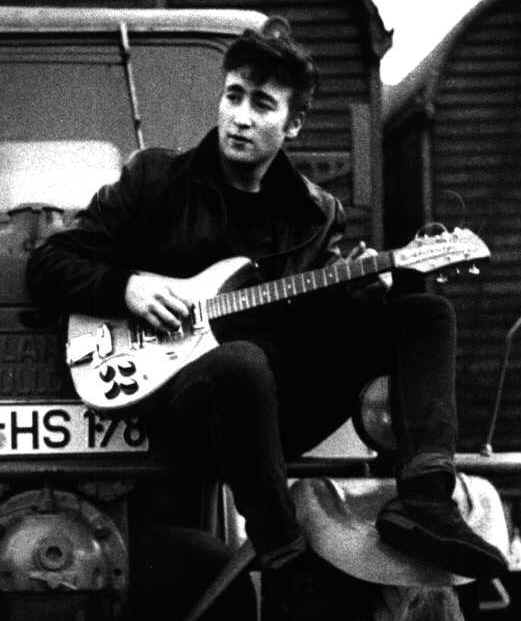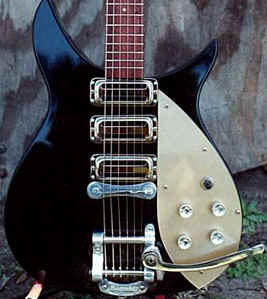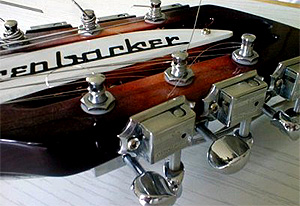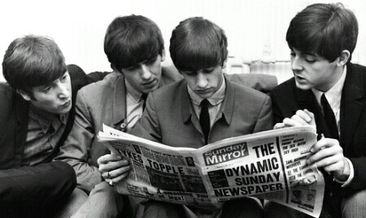 and their Rickenbacker
guitars
and their Rickenbacker
guitars
By Bjurn Eriksson
The Beatles had Rickenbacker guitars and
Rickenbacker guitars had the Beatles. Would The Beatles have had their great success
without the Rickenbacker guitars? Of course they would! Whether Rickenbacker guitars would have had their great
success without the Beatles is an interesting question about which we can only speculate.
A more valuable and interesting pursuit would be to explore the importance of
Rickenbackers in the music of the Beatles.
We will never get a chance to know for
sure out so letґs drop the speculations here and now! Instead let us look back! In my
opinion there has never been a Rickenbacker - Artist symbiosis like the one between John
Lennon and his Rickenbacker 325.
Welcome to the story of The Beatlesґ
Rickenbackers! I hasten to remind you dear reader, that this is the story seen through my
own eyes and the views expressed herein, should not be held up to the highest standard of
scientific scrutiny.
NOTE! Because of problems to find the
copyright holders of many Beatles-pictures, I will add more pictures to this article as
soon as I get permissions.
PART 1
John Lennonґs '58 Rickenbacker 325
The Beatles went to Hamburg in August 1960.
John had seen guitarist Jean "Toots" Thielemans, George Shearingґs Quintet,
playing a Rickenbacker 325 in 1959. He immediately became interested in the guitar. One
day John and George went to Steinwayґs in Hamburg (local research suggests that the
guitar may have been acquired from the nearby Musikhaus Rothoff). George bought a Gibson amplifier and John bought the
"guitar of his dreams", a Rickenbacker Capri 325 in natural finish.
Itґs quite amazing to see that the connection
between "Toots" and the Capri
325 began as early as 1958! When
bringing the question up about the cost of the amplifier and the guitar George Harrison
recalls: - I think we
bought them on "a knocker". One pound down and the rest when they catch you. He
adds: - I donґt know if we ever paid them off, but.....??

The guitar to the left of Toots
Thielemansґ elbow is most certainly John Lennonґs first Capri 325 before it was
fitted with four control knobs. This picture is from Trade Show in July 1958.
© 1999 by Rickenbacker Int'l Corp.
All rights reserved. Used by permission.

Hereґs another photo from the Trade Show
1958. John Lennonґs Capri 325 is the guitar to the left in the bottom row, equipped with
two control knobs and a Kauffman Vibrola tailpiece. © 1999 by Rickenbacker Int'l
Corp. All rights reserved. Used by permission.

1960. John Lennon in Hamburg on a
fairground, near the Reeperbahn, called "Heiligengeistfeld". His guitar is still
unmodified. ©1999 Astrid Kircherr. All rights
reserved. Used by permission.
In Hamburg John Lennon soon started to modify
his guitar. The first alteration he made was to remove the TV-style control knobs and
replace them with Hofner types. Through the years he was using both Burns and Hofner type
knobs. It seems he was either constantly losing them or perhaps could not decide which
type were more appealing. There is a
picture on p.45 in "The
Vox Story" (Petersen & Denny, 1993) showing Johnґs guitar with only three Hofner
type knobs. After returning to Liverpool he replaced the Kauffman Vibrola tailpiece. He
bought a Bigsby unit from salesman Jim Getty at Hessyґs music store in Liverpool. Also a
new Bigsby bow-tie bridge was mounted. The guitar was put on the counter and the modifications were made while still being in
the store. Perhaps the reason for this was that the Kauffman Vibrola rarely returned to
pitch and threw the instrument out of tune. It would appear that the Bigsby was considered
as a more reliable vibrato
tailpiece. Unfortunately the Bigsby bridge was
somewhat oversized for the smaller 325 body. It was probably the pickguard that prevented it from fitting properly
or perhaps it was improperly installed. Pictures of the guitar reveal that the low E or
6th string was out of alignment and actually was outside the fretboard and off the neck
from somewhere around the 14th fret and higher.(see "Imagine John Lennon" by
Yoko Ono 1988, picture on p. 73.)
It would also seem that the middle pickup was
disconnected.One plausible reason for this altered wiring might have been to achieve
greater difference in tone between the
different pickup-switch positions. Most of the pictures of John playing this guitar reveal
that the pickup-switch is set to the
mid-position. An up or down position would result in a more distinct change in tonal
characteristics. Whether this was a deliberate action on Johnґs part or not, is not known. After all John Lennon did not have the reputation of being the
most technically minded person.
Please note that the fact that his middle
pickup was disconnected has not, to my knowledge, been verified by John himself in any
interviews. Maybe the reason simply was that the pickup had been damaged from being hit
hard a countless number of times, while John was strumming wild (or damaged because of
some other reason), and he just left it that way. After all he never modified his other
325 (Miami) or 1996 (Rose,Morris) guitars to have that same pickup wiring.

John Lennon's Capri 325 from 1958
There are few topics that hold the attention of avid Beatle
fans more than the guitars played by the Fab Four in general, and by John Lennon in
specific. His adopting of the 325 Rickenbacker and his eventual refinishing to black has
sent many an enthusiast on the hunt for the reasons underlying this change. Whatever the
reason, no single guitar at that time had the
impact of Lennon's black 325. The reasons for its change in color are not known, however,
the most realistic explanation is probably Lennon's pension for the unusual and different.
The Cuban footwear, the leather hat, the long beard, the Lennon spectacles, the purple
shirts and the shaved head are but a few examples of his trend setting ways. So why should
his guitar be any different?
Jim Burns, of Burn's Guitar fame, is credited with the finishing. The 325 in its natural
finish is portrayed in a photo of the Beatles rehearsing at the Cavern in October 1962.
The first photo of Lennon with the 325 with black finish was taken on December 31, 1962 at
their last performance at the Star Club in Hamburg, Germany.
So the refinishing of Lennon's instrument was sometime between October and mid December
1962.
Another possible reason for the
refinishing was to make it match Georgeґs black Gretsch Duo Jet, which was his main
guitar at that period. It is also known that Johnґs guitar was quite scratched and beaten
after being heavily used for a long time, and badly in need of cosmetic changes. Also the white pickup-switch was replaced with a black one. Finally, black was Johnґs favorite "color". Maybe another
reason?
The pictures below provides an excellent
illustration of how John Lennonґs guitar looked after being refinished.

"1958" 325 Capri. Reproduction of John
Lennonґs first Rickenbacker after being
refinished by Jim Burns in 1963. ©1999 Mark Vaquer. All rights reserved. Used by
permission.
Here are the specifications:
* Correct 2 inch thick body w/ 1/8 inch thick back
* Correct (Lennon) shaped headstock w/ 50's logo & correct screws
* Unfinished fretboard
* Elongated Jackplate
* Raised single gold pickguard w/ correct (Lennon) "5" mount screw points
* Burns reproduction knobs
* 1960's Bigsby w/ Aluminum handle w/ "Phillips" head stud
* Thick string nut (as on early '58 325's)
* No volute on back of headstock base
* Short pole pickups re-wound to 50's specs


Left: 325 Capri 1958 reproduction. Right: Picture highlighting the correct shaped headstock, headstock logo
& thick nut on this repro '58 325 (no serial#). ©1999 Mark Vaquer. All rights
reserved. Used by permission.

The 2" thick body on the 325 Capri reproduction.
©1999 Mark Vaquer. All rights reserved. Used by
permission.

John Lennon with his '58 Rickenbacker 325 at the City
Hall in Sheffield, November 2 1963. ©1999
Corbis Pictures. All
rights reserved. Used by permission.
George Harrisonґs Rickenbacker 425
The second Beatle to get himself a Rickenbacker was George
Harrison. In September 1963 he bought a Jetglo model 425, while visiting his sister Louise
in Benton, Illinois. In a letter I have received from her she confirms that George
bought this guitar in a music store in Mount Vernon, Illinois.
Mr. Bill Beatty, who owns the music store
"Beattyґs" in West City near Benton, Illinois recalls this event and is able to
confirm that he spoke with the two men who sold George his Rickenbacker. The store was
Fentons Music Store in Mount Vernon, Illinois, and the man who claims to have been the one
to sell it was "Tiny" Len Wymette.
This instrument never became Georgeґs favorite. He only used
it for a short time. He can be seen using the guitar in "Ready Steady Go", a
TV-show broadcasted on October 4 1963 (now available on video-cassette).

George Harrison with his 425 in Sheffield, Nov 2 1963.
©1999 Corbis Pictures. All rights reserved. Used by permission.
An Historical Date
(George Harrisonґs first 360/12)
February 8th, 1964 was a day when
Rickenbacker (read Francis C.Hall) really made a very powerful contribution to the sound of the
sixties.That day Mr. Hall invited The Beatles (John, Paul and Ringo) to his hotel suite at
the Savoy Hilton Hotel in NYC.There he
showed them his newest "invention", the electric twelve-string.George Harrison,
who was back at the Plaza Hotel, had the flu and stayed in bed.The other boys wanted to give him a chance to try out this new guitar,
so off they went to his hotel.George, who was giving a telephone interview for the radio
station WDGY in Minneapolis, tried out
this new guitar.When he told the DJ about the guitar the radio station offered him the instrument as a gift.But Francis C. Hall
had already decided to give away this instrument, and so he did. George Harrison appeared to be rather confused
about the party from whom he received the gift.A further elaboration of this situation is
discussed later in the article. By introducing the Rickenbacker twelve string guitar
Francis C. Hall added a dimension to the sound of the sixties that was
adopted by a countless number of groups all over the world. This
brilliant business idea from Mr. Hall increased the popularity of his guitars enormously.
Both the Rickenbacker company and the many musicians were to benefit from the introduction
of the first electric 12 string guitar.
George Harrisonґs first 360/12 was the
second Rickenbacker twelve string ever made. The prototype
had somewhat different features. The most significant difference between the two is the
manner in which they are strung. The first twelve string manufactured had a
conventional twelve string setup. On Georgeґs guitar, the octave counterparts to the four
lower strings, were reversed with the octave strings occurring second in the string pairs.
It was the first Rickenbacker strung in this manner. This is why Mr. F.C Hall often refers
to it the first H E R E!
While Harrison's 12 string was the second one
made, nonetheless, it had the distinction of being a prototype for all subsequent
instruments as far as the manner in which they would be strung.George Harrisonґs guitar
had a crescent soundhole, triangle inlays, trapeze tailpiece, double white pickguards and
black control knobs. The color is FireGlo. This model is available in a reissue version,
the model 360/12V64.

The brilliant headstock solution (360/12V64)
©1999 Bjцrn Eriksson
He still uses his first twelve string. You
can hear it in the song "Fish On The Sand" from the album "Cloud Nine"
( 1987). George Harrison says:
" - The guitar is really good. I love the sound of it and the brilliant way where the
machine heads fit so that even when youґre drunk you can still know what string youґre
tuning."
Below is the story told by George Harrison,
in his own words, from a radio interview in 1988:
" - First one I ever saw was when Beatles were in
Hamburg on their first trip and we went into the shop Steinwayґs in Hamburg and I bought
a Gibson amplifier and John bought that little Rickenbacker that, you know, became very
well known through the Beatle concerts. There was this scaled neck. I think heґd just
seen an album by a guy, Jean Thielemans, who used to be guitar player with "The
George Shearing Quintet", and he had one of those Rickenbackers.
Later when we went to America, I think for the Ed Sullivan Show
in February of 1964, there was a show Rickenbacker had in this hotel suite, but I was sick
at the time, I never made it, but I thought Rickenbacker had personally given me this
guitar which was the twelve string I used right through Hard Dayґs Night, Ticket To Ride
and all those songs.I actually use it on my new album, Cloud Nine, itґs on a song called
"Fish On The Sand". So thatґs it, but that Rickenbacker is the number two,
apparently itґs the second one made, and I found out that it was actually a radio station
bought it from Rickenbacker and presented it to me.
Well, you have to imagine in those days as we were first out of
Liverpool any good American guitar looked sensational to us, and we only had old beat-up,
crummy guitars at that stage, and we still really didnґt have any money to buyґem but I
remember we bought, like John got that Rickenbacker and I got this amplifier and we got
them on, what they call, on "a knocker", you know, pound down, the rest when
they catch you, and...we... I donґt know if we ever really paid them off, but...
It was a great looking guitar and I think in England you had to
order them specifically and wait from six months, you know not just for Rickenbackers, for
anything, Fenders and Gibsons, and I think it was purely that John needed a decent guitar
and that one just happened to be in the shop, and that he liked the look of it.
That was 1964 when I got that guitar in the Plaza Hotel in New
York, we were there to do the Ed Sullivan shows, and straight away I liked the guitar
because you knew exactly which string was which.Some of them twelve strings, you know, you
spend hours trying to tune in, youґre turning the wrong knobs, so many of them. So I
started using it then and in the next session after the initial Beatle trip to the USA. It
was probably Hard Dayґs Night, itґs right there on the opening downbeat of Hard Dayґs
Night, that chord, and I used it right through "I should Have Known Better",
right through lot of the songs in Hard Dayґs Night, and I think the last Beatle song was,
that I recall playing on was, the Rickenbacker twelve string, was "Ticket To
Ride".
The strange thing about the guitar, really, I donґt think the
electronics in it is very good. I donґt know if they have improved it, they probably have
by now, but they have like a whole bunch of controls on it, I think four knobs and a
little tiny knob, and I never.., it never seem to do anything. All it ever seemed to be
there was one sound I could get where it was bright, which is the sound I use, and there
was another tone where it just all went muffely, which I never used, but it really didnґt
seem to do anything other than this bright sound, but that is the sound that you hear on
Ticket To Ride and all those others we mentioned.
The twelve string was pretty easy really as long as it was in
tune, you know, you always had that problem with twelve string getting it really in tune.
But, as I said, the neck on it was very easy. In fact, having not played it for years and
I just played it again recently, I was surprised the neck is actually so narrow that you
have to be very careful when youґre clamping the strings down there because, you know,
the first and sixth strings can slip off the side of the neck if you pressґem on an
angle. But itґs pretty good from what I remember. I used to play it in concerts for years
and it never gave me any trouble.
Yeah, well Iґm pleased to say I still got that guitar, itґs a
great classic guitar now I think. I got it hanging on a wall at home and as I said I use
it on "Fish On The Sand" which a few people have said, oh ,it reminds them of
some Beatle tune, I donґt know, but thatґs purely because the sound of it, that sound
you just associate with those early sixtiesґ Beatle records. The twelve string
Rickenbacker sound is a sound on its own. "
A close look in Lewisohnґs book "The
Complete Beatles Recording Sessions" reveal that the first song recorded in 1964 with
the twelve string guitar was "I should Have known Better". The recording dates
are February 25 (take 1-3) and February 26 (take 4-22). The next song recorded with the
twelve string was "I Call Your Name" on March 1. The twelve string pattern on
this song really introduces the "new" sound, giving the song a very special
touch. The song that maybe is
most connected with the twelve string, "A Hard Dayґs Night" ,was recorded on
April 16 (1964).


Left: The second Rickenbacker 360/12 ever made. George
Harrison received this guitar on
February 8 1964 as a gift from Francis C. Hall at Rickenbacker. Right: John Lennonґs one-of-a-kind 325/12. Shipped to London by the
Rickenbacker company in March 1964.
© 1999 by Rickenbacker Int'l Corp.
All rights reserved. Used by permission.

 | Группа "Гости" | RSS
| Группа "Гости" | RSS 
 | Группа "Гости" | RSS
| Группа "Гости" | RSS 